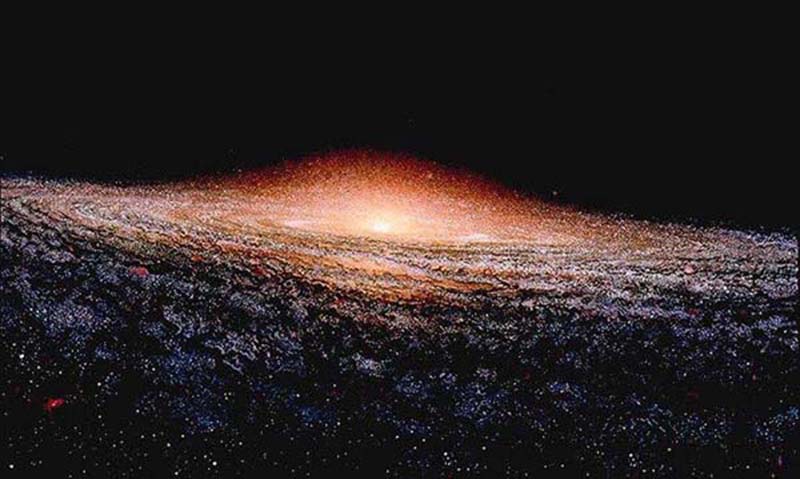

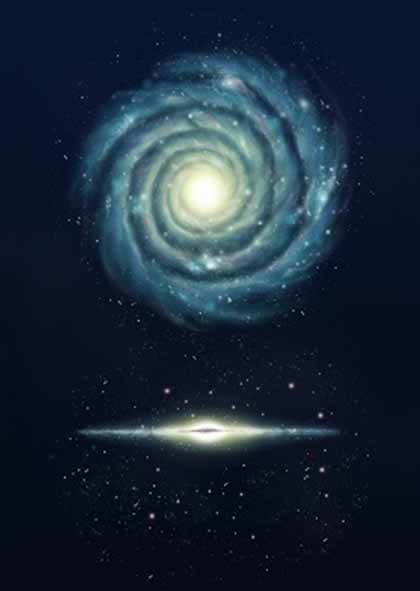
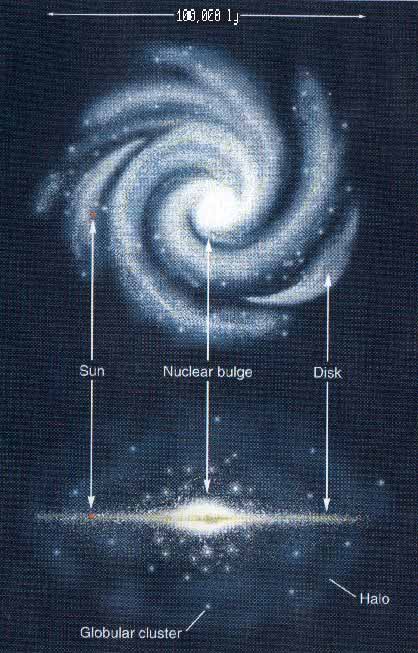
The Milky Way is the galaxy that contains the Solar System, with the name describing the galaxy's appearance from Earth: a hazy band of light seen in the night sky formed from stars that cannot be individually distinguished by the naked eye. The Milky Way is a barred spiral galaxy with a visible diameter between 150,000 and 200,000 light-years. It is estimated to contain 100-400 billion stars and at least that number of planets. The dark matter halo around the Milky Way may span as much as 2 million light years. The Solar System is located at a radius of about 27,000 light-years from the Galactic Center, on the inner edge of the Orion Arm, one of the spiral-shaped concentrations of gas and dust. The stars in the innermost 10,000 light-years form a bulge and one or more bars that radiate from the bulge. Read more
The Galactic Center is the rotational center of the Milky Way galaxy; it is a supermassive black hole of 4.100 Ī 0.034 million solar masses which powers the compact radio source Sagittarius A*. It is far from Earth in the direction of the constellations Sagittarius, Ophiuchus, and Scorpius where the Milky Way appears brightest. Read more
As Aristotle (384-322 BC) informs us in Meteorologica (DK 59 A80), the Greek philosophers Anaxagoras (ca. 500-428 BC) and Democritus (450-370 BC) proposed that the Milky Way might consist of distant stars. However, Aristotle himself believed the Milky Way to be caused by "the ignition of the fiery exhalation of some stars which were large, numerous and close together" and that the "ignition takes place in the upper part of the atmosphere, in the region of the world which is continuous with the heavenly motions."
The Arabian astronomer, Alhazen (965-1037 AD), refuted this by making the first attempt at observing and measuring the Milky Way's parallax, and he thus "determined that because the Milky Way had no parallax, it was very remote from the earth and did not belong to the atmosphere."
The Persian astronomer, Abu Rayhan al-Biruni (973-1048), proposed the Milky Way galaxy to be a collection of countless nebulous stars.
Avempace (d. 1138) proposed the Milky Way to be made up of many stars but appears to be a continuous image due to the effect of refraction in the Earth's atmosphere.
Ibn Qayyim Al-Jawziyya (1292-1350) proposed the Milky Way galaxy to be "a myriad of tiny stars packed together in the sphere of the fixed stars" and that that these stars are larger than planets.
Actual proof of the Milky Way consisting of many stars came in 1610 when Galileo Galilei used a telescope to study the Milky Way and discovered that it was composed of a huge number of faint stars.
In a treatise in 1755, Immanuel Kant, drawing on earlier work by Thomas Wright, speculated (correctly) that the Milky Way might be a rotating body of a huge number of stars, held together by gravitational forces akin to the Solar System but on much larger scales. The resulting disk of stars would be seen as a band on the sky from our perspective inside the disk. Kant also conjectured that some of the nebulae visible in the night sky might be separate "galaxies" themselves, similar to our own.
The first attempt to describe the shape of the Milky Way and the position of the Sun within it was carried out by William Herschel in 1785 by carefully counting the number of stars in different regions of the visible sky. He produced a diagram of the shape of the Galaxy with the Solar System close to the center.
In 1845, Lord Rosse constructed a new telescope and was able to distinguish between elliptical and spiral-shaped nebulae. He also managed to make out individual point sources in some of these nebulae, lending credence to Kant's earlier conjecture.
In 1917, Heber Curtis had observed the nova S Andromedae within the "Great Andromeda Nebula" (Messier object M31). Searching the photographic record, he found 11 more novae. Curtis noticed that these novae were, on average, 10 magnitudes fainter than those that occurred within our galaxy. As a result he was able to come up with a distance estimate of 150,000 parsecs. He became a proponent of the "island universes" hypothesis, which held that the spiral nebulae were actually independent galaxies.
In 1920 the Great Debate took place between Harlow Shapley and Heber Curtis, concerning the nature of the Milky Way, spiral nebulae, and the dimensions of the universe. To support his claim that the Great Andromeda Nebula was an external galaxy, Curtis noted the appearance of dark lanes resembling the dust clouds in the Milky Way, as well as the significant Doppler shift.
The matter was conclusively settled by Edwin Hubble in the early 1920s using a new telescope. He was able to resolve the outer parts of some spiral nebulae as collections of individual stars and identified some Cepheid variables, thus allowing him to estimate the distance to the nebulae: they were far too distant to be part of the Milky Way. In 1936, Hubble produced a classification system for galaxies that is used to this day, the Hubble sequence.
The name is from the Greek root galaxy, meaning "milky," a reference to the Milky Way Galaxy.
There are numerous legends in many traditions around the world regarding the creation of the Milky Way. In particular there are two similar ancient Greek stories that explain the etymology of the name 'Galaxias' and its association with milk.
One legend describes the Milky Way as a smear of milk created when the baby Herakles suckled from the Goddess Hera. When Hera realized that the suckling infant was not her own but the illegitimate son of Zeus and another woman, she pushed it away and the spurting milk became the Milky Way Galaxy. �
Another story tells that the milk came from the goddess Rhea, the wife of Cronus, and the suckling infant was Zeus himself. Cronus swallowed his children to ensure his position as head of the Pantheon and sky god, and so Rhea conceived a plan to save her newborn son Zeus: She wrapped a stone in infant's clothes and gave it to Cronus to swallow. Cronus asked her to nurse the child once more before he swallowed it, and the milk that spurted when she pressed her nipple against the rock eventually became the Milky Way.
Older mythology associates the constellation with a herd of dairy cows/cattle, whose milk gives the blue glow, and where each cow is a star. As such, it is intimately associated with legends concerning the constellation of Gemini, which it is in contact with. Firstly, with Gemini, it may form the origin of the myth of Castor and Polydeuces, concerning cattle raiding. Secondly, again with Gemini, but also with other features of the Zodiac sign of Gemini (i.e. Canis Major, Orion, Auriga, and the deserted area now regarded as Camelopardalis), it may form the origin of the myth of the Cattle of Geryon, one of The Twelve Labours of Herakles.
Civilizations in Eastern Asia believed that the hazy band of stars were "Silvery River" of the Heaven. Also, Altair and Vega were thought to be lovers, who were bound not to meet each other but on the seventh day of the seventh month, Qi Xi (Tanabata in Japan and Chilseok in Korea), when the magpies form the bridge over the galactic river.
The Milky Way Galaxy is the inspiration for the symbol of the Ouroboros. In mythology the Milky Way Galaxy keeps a 'great time cycle' that ends in catastrophic change. This refers to a serpent of light (Milky Way) residing in the heavens, who, when viewed at the galactic central point near Sagittarius, eats its own tail. Suntelia Aion refers to the sun (light) rising out of the mouth of the ouroboros (aion) on the winter solstice December 21, 2012. Ancient historians, and especially Plato, referred to a cycle of catastrophe at the End of that Age.

The God Equation: Creation is based on the Fibonacci sequence.
The Human Equation: The brain works on binary code.
It's all an algorithm in the alchemy of time.
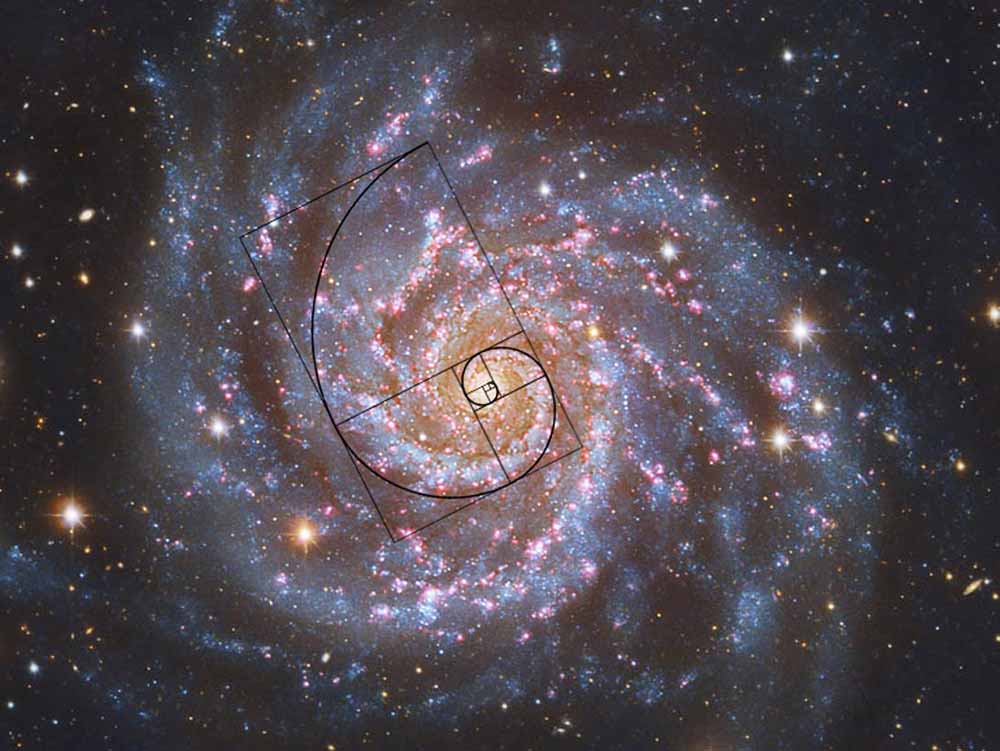
The center of the Milky Way Galaxy is sometimes referred to as the Ouroboros - the snake that eats its tail in the end or coming full circle - black energy (quintessence) - return through the shimmering black hole of creation. In 2012 someone on Ancient Aliens linked it to the Mayan Calendar Prophecy about coming full circle on December 21, 2012. In Numerology we find 12/21/12 or 12+21+12= 9= Endings. No matter where the mythology, numerology, prophecy, or celestial messages take you - it all begins and ends with a shimmering black hole in the alchemy of time.
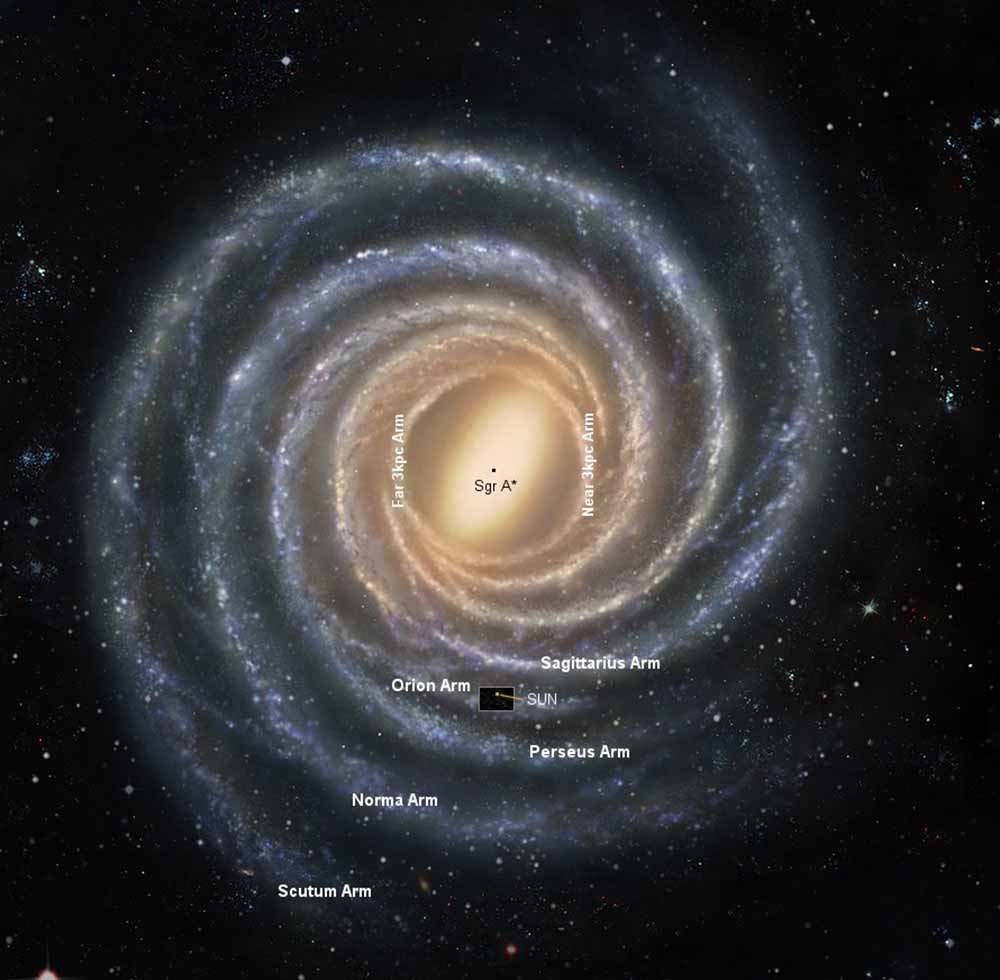
The First-Ever Image of The Black Hole at The Center of The Milky Way
Science Alert - May 12, 2022
This image reminds me of a UFO
Sagittarius A* is a bright and very compact astronomical radio source at the Galactic Center of the Milky Way. Sagittarius A* is the location of a supermassive black hole, similar to massive objects at the centers of most, if not all, spiral and elliptical galaxies. On May 12, 2022, astronomers using the Event Horizon Telescope released a photograph of Sagittarius A*, confirming the object to contain a black hole. Continue reading
One of The Milky Way's 'Bones' Was Just Fully Mapped For The First Time Science Alert - April 6, 2022
That bone is a long, dense filament of cold gas in the densest part of one of the galaxy's spiral arms. It measures around 195 light-years in length; the map, acquired using the Stratospheric Observatory for Infrared Astronomy (SOFIA) plane, gives us the first complete picture of the magnetic fields therein. The result defies expectations. Rather than aligned along the length of the bone, the magnetic fields are more higgledy-piggledy, and the average magnetic field is neither parallel nor perpendicular to the bone. This, the researchers said, can help us to better understand not just the structures of spiral galaxies, but their star formation.
Astronomers discover 1,000 strange 'filaments' of radio energy bursting from the galaxy's center Live Science - January 29, 2022
There are 10 times more of these structures than we realized and their source remains a mystery.
Jaw-Dropping View of The Milky Way Reveals Mysterious Structures Dangling in Space Science Alert - January 27, 2022

A new image of the heart of the Milky Way is revealing mysterious structures we've never seen before. Taken using the ultra-sensitive MeerKAT radio telescope in South Africa, the images show nearly 1,000 strands of magnetic filaments, measuring up to 150 light-years in length, in surprisingly neat and regular arrangements.
Astronomers find the biggest structure in the Milky Way: A filament of hydrogen 3,900 light-years long PhysOrg - January 6, 2022
Roughly 13.8 billion years ago, our universe was born in a massive explosion that gave rise to the first subatomic particles and the laws of physics as we know them. About 370,000 years later, hydrogen had formed, the building block of stars, which fuse hydrogen and helium in their interiors to create all the heavier elements. While hydrogen remains the most pervasive element in the universe, it can be difficult to detect individual clouds of hydrogen gas in the interstellar medium (ISM). This makes it difficult to research the early phases of star formation, which would offer clues about the evolution of galaxies and the cosmos. An international team led by astronomers from the Max Planck Institute of Astronomy (MPIA) recently noticed a massive filament of atomic hydrogen gas in our galaxy. This structure, named Maggie, is located about 55,000 light-years away (on the other side of the Milky Way) and is one of the longest structures ever observed in our galaxy.
NASA reports that Hubble found evidence that Sagittarius A* - the Milky Way’s supermassive black hole is leaking a jet of hot gas Mysterious Universe - December 14, 2021
While Sagittarius A* is said to be in a powered down state at the moment, it apparently still shows signs of activity when something gets sucked into its supermassive mouth and it belches out some gas.
Astronomers discover strangely massive black hole in Milky Way satellite galaxy PhysOrg - December 1, 2021
Astronomers at Austin's McDonald Observatory have discovered an unusually massive black hole at the heart of one of the Milky Way's dwarf satellite galaxies, called Leo I. Almost as massive as the black hole in our own galaxy, the finding could redefine our understanding of how all galaxies - the building blocks of the universe - evolve.
'Gangotri wave' connecting two of Milky Way's spiral arms discovered PhysOrg - November 28, 2021
A team of researchers discovered a long thin filament of dense gas connecting two of the Milky Way galaxy's spiral arms. Prior research has shown that other galaxies have features called feathers - long gas filaments with barbs that look from Earth like feathers. But because it is very difficult to study the Milky Way galaxy from an Earth perspective, no such features have been seen, until now.
Astronomers find a 'break' in one of the Milky Way's spiral arms PhysOrg - August 17, 2021
Scientists have spotted a previously unrecognized feature of our Milky Way galaxy: A contingent of young stars and star-forming gas clouds is sticking out of one of the Milky Way's spiral arms like a splinter poking out from a plank of wood. Stretching some 3,000 light-years, this is the first major structure identified with an orientation so dramatically different than the arm's.
A fast radio burst was detected from within our galaxy for the first time. We may be closer to uncovering its origin. Live Science - July 6, 2021
On April 28, 2020, two ground-based radio telescopes detected an intense pulse of radio waves. It only lasted a mere millisecond but, for astonished astronomers, it was a major discovery, representing the first time a fast radio burst (FRB) had ever been detected so close to Earth.
Dark matter is slowing the spin of the Milky Way's galactic bar PhysOrg - June 15, 2021
The spin of the Milky Way's galactic bar, which is made up of billions of clustered stars, has slowed by about a quarter since its formation. For 30 years, astrophysicists have predicted such a slowdown, but this is the first time it has been measured.
Variable emission from the Milky Way's supermassive black hole PhysOrg - June 12, 2021
At the center of our Milky Way lies a supermassive black hole (SMBH) called Sagittarius A* (SgrA*). Supermassive black holes reside at the centers of most galaxies, and when they actively accrete gas and dust onto their surrounding hot disks and environments, they radiate across the electromagnetic spectrum. The mass of SgrA* is about 4 million solar masses, much smaller than the billions of solar-mass SMBHs seen in some galaxies. However, it is relatively close by, only about 25,000 light-years distant, and this proximity provides astronomers with unique opportunities to probe the properties of SMBHs.
Sag A* has been monitored at radio wavelengths since its discovery in the 1950s. Variability was first reported in the radio in 1984, and subsequent infrared, submillimeter, and X-ray observations confirmed variability and found that it often flares. Monitoring programs have concluded that on average Sgr A* is accreting material at a very low rate, only a few hundredths of an Earth mass per year. The fascination with SgrA*'s variability has a practical diagnostic reason, too: Changes in emission are a measure of the dimensions of the region, set by the time for light to travel across it. Flares have been measured that doubled in strength in less than 47 seconds, for example, a time that corresponds to a distance about as small as this black hole's fundamental event horizon size (light cannot escape from within this boundary). These conclusions are in agreement with size inferences made with radio and near infrared interferometry.
What if the black hole at the center of the Milky Way is actually a mass of dark matter? PhysOrg - June 2, 2021
A team of researchers at the International Center for Relativistic Astrophysics has found evidence that suggests Sagittarius A* is not a massive black hole but is instead a mass of dark matter. For several years the scientific community has agreed that there is a mass at the center of the Milky Way galaxy and that the mass is a supermassive black hole - it has been named Sagittarius A*. Its presence has never been verified directly, however, instead it has been inferred by noting the behavior of bodies around it. In this new effort, the researchers suggest that another type of mass could produce the same reactions by other bodies and in fact could help explain some anomalies that have been seen.
Astronomers chart invisible ocean of dark matter swirling outside the Milky Way Live Science - May 5, 2021
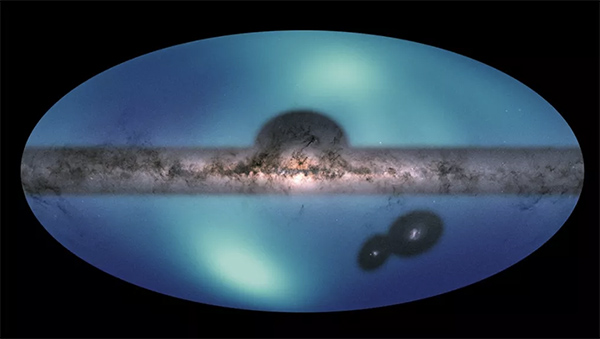
A mysterious wake of stars, stirred up by a small galaxy that is set to collide with the Milky Way, could be about to unlock the mysteries of dark matter. The trail of stars, located outside the star-flecked spiral arms of the Milky Way's central disk in a region called the galactic halo, is being carried along in the cosmic slipstream of a dwarf galaxy in orbit around the Milky Way, according to a new sky map created by astronomers. The galaxy, called the Large Magellanic Cloud (LMC), is orbiting some 130,000 light-years away from Earth and stirring up the wake of cosmic material behind it. At first glance, the LMC’s trail appears to consist solely of stars, but the researchers know that the stars are just along for the ride. They are suspended inside a far larger, completely invisible presence.
Astronomers release new all-sky map of the Milky Way's outer reaches PhysOrg - April 21, 2021
Astronomers using data from NASA and the ESA (European Space Agency) telescopes have released a new all-sky map of the outermost region of our galaxy. Known as the galactic halo, this area lies outside the swirling spiral arms that form the Milky Way's recognizable central disk and is sparsely populated with stars. Though the halo may appear mostly empty, it is also predicted to contain a massive reservoir of dark matter, a mysterious and invisible substance thought to make up the bulk of all the mass in the universe.
Newly Discovered Region of The Milky Way Is Filled With Stars Ready to Blow Up Science Alert - April 10, 2021
An X-Ray Hourglass Is Emerging From the Middle of the Milky Way Smithsonian - December 15, 2020
Astrophysicists conducting a survey of our very own Milky Way galaxy with an X-ray telescope aboard a satellite spotted a pair of enormous plasma bubbles, reports Leah Crane for New Scientist. The blobs of hot gas extend more than 45,000 light years above and below the disc of the Milky Way itself, according to new research published in the journal Nature. That’s almost as tall as the entire galaxy is wide—the Milky Way measures around 105,000 light years across.
It's Official: The Fast Radio Burst Coming From Within Our Galaxy Is Repeating Science Alert - November 17, 2020
The first object within the Milky Way galaxy caught emitting fast radio bursts is now officially a repeater. In a new peer-reviewed paper, SGR 1935+2154 has been described spitting out two more powerful radio signals consistent with those seen from extragalactic sources. The new signals, however, are not all the same strength. This suggests that there could be more than one process inside magnetars that are capable of producing these enigmatic bursts - and that SGR 1935+2154 could be a dream come true, an excellent laboratory for understanding them. Fast radio bursts have been a puzzle since their discovery in 2007. They're extremely powerful bursts of energy only in radio frequencies, lasting just milliseconds long at most. And there were several major difficulties in figuring out what they were.
Weird Structures Found to Be Ancient Leftovers of Violent Milky Way Collision Science Alert - October 26, 2020
In 2005 astronomers found a dense grouping of stars in the Virgo constellation. It looked like a star cluster, except further surveys showed that some of the stars are moving towards us, and some are moving away. That finding was unexpected and suggested the stream was no simple star cluster.
The Milky Way's quiet, introverted monster won't spin Live Science - October 30, 2020
There's a beast hiding at the center of the Milky Way, and it's barely moving. This supermassive black hole, Sagittarius A* (SgrA*), has a mass 4.15 million times that of our sun. It first revealed itself to scientists as a mysterious source of radio waves from the galaxy's center back in 1931; but it wasn't until 2002 that researchers confirmed the radio waves were coming from something massive and compact like a black hole - a feat that earned them the 2020 Nobel Prize in physics. Just days before the team learned about their Nobel on Oct. 6, another group learned something new about the black hole: It's spinning more slowly than a supermassive black hole should, moving less than (possibly far less than) 10% of the speed of light. Black holes, despite their awesome power, are extraordinarily simple objects. All the distinguishing features of the matter that forms and feeds them gets lost in their infinitesimal singularities. So every black hole in the galaxy can be described with just three numbers: mass, spin and charge.
The First Star in Our Galaxy Caught Sending Out Fast Radio Bursts Is Doing It Again Science Alert - October 22, 2020
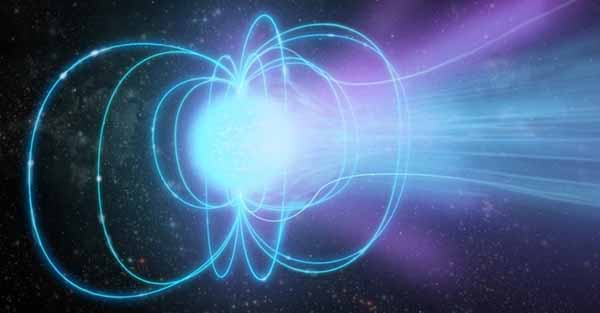
A little dead star that dazzled us earlier this year is not done with its shenanigans. Magnetar SGR 1935+2154, which in April emitted the first known fast radio burst from inside the Milky Way, has flared up once more, giving astronomers yet another chance to solve more than one major cosmic mystery.
Mystery Gas Has Been Detected Shooting 'Like Bullets' From Our Galactic Centre Science Alert - August 19, 2020
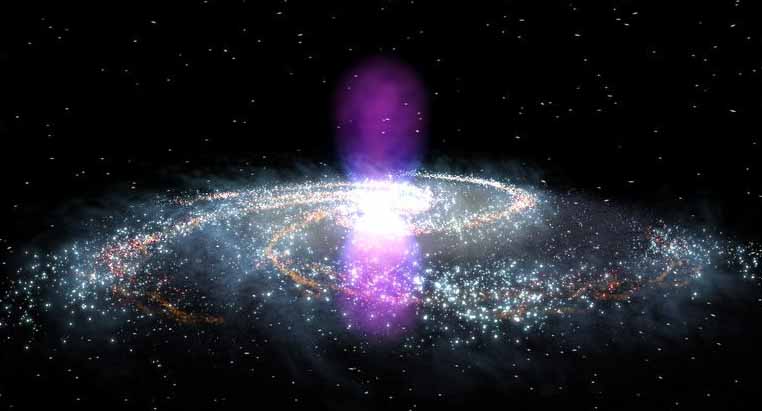
There's a lot going on in the centre of our galaxy. The Milky Way's core is home to a supermassive black hole as massive as 4 million Suns called Sagittarius A*, and the environment around it is intense. Blowing out from this region is a nuclear galactic wind. It's carved out two huge gamma-ray bubbles above and below the galactic plane, extending a total of 50,000 light-years into space. These Fermi bubbles are complex, containing a mix of different gases and cosmic rays. But astronomers have just spotted something new. Within the Fermi bubbles are high-velocity clumps of cold molecular gas - the stuff that stars are made of. Even better, they're not sure how the galactic centre spat that gas out "like bullets", according to the researchers.
A New Organic Molecule Has Been Detected in Our Galaxy's Interstellar Space Science Alert - June 18, 2020

Near the center of the Milky Way, in a vast cloud in the space between the stars, astronomers have identified an organic molecule never before detected in the interstellar medium. It's called propargylimine, and it could play a key role in the formation of the amino acids vital for the emergence of life.
Mysterious 'Fermi Bubbles' may be the result of black hole indigestion 6 million years ago Live Science - May 28, 2020
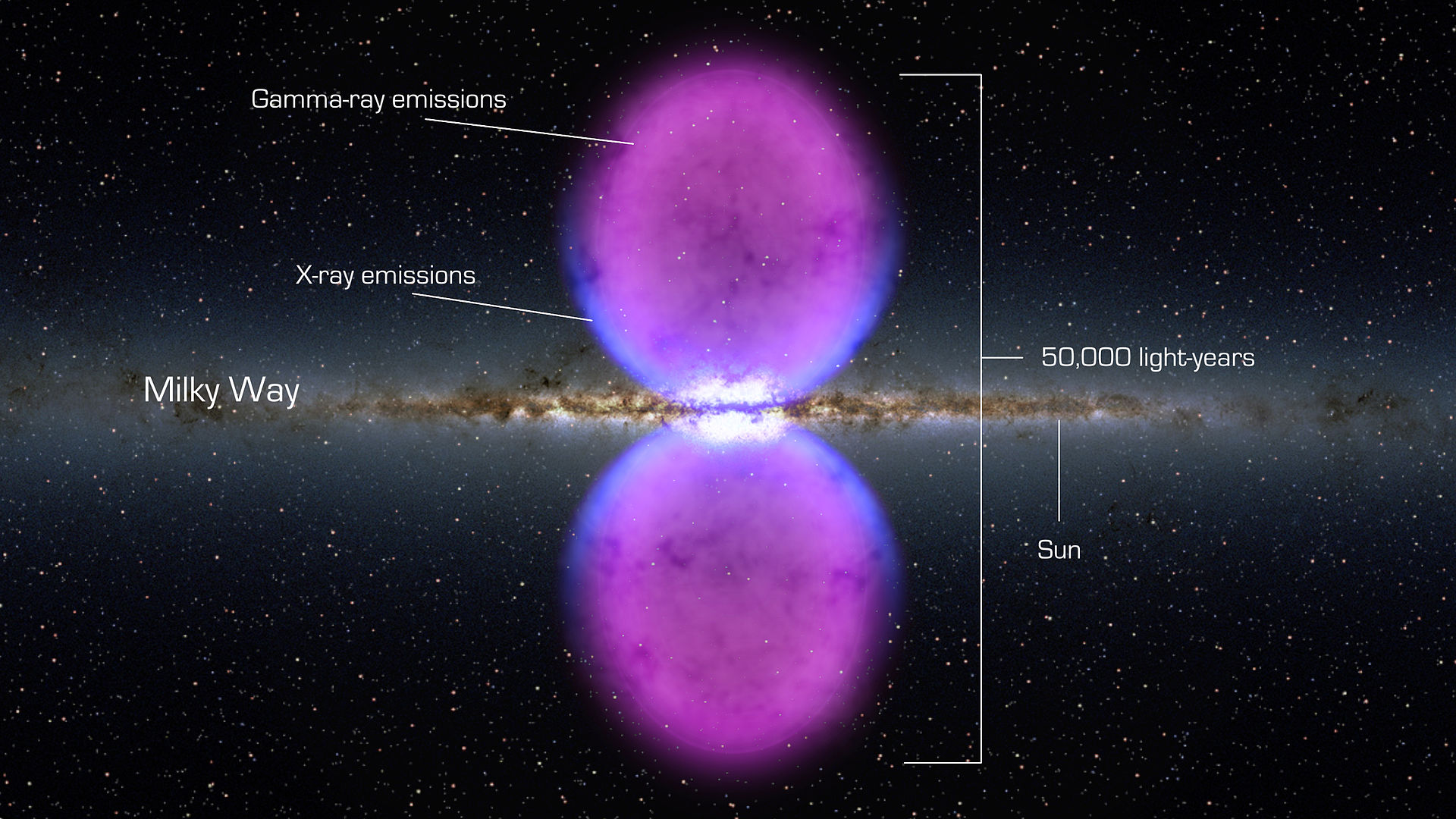 In November 2010, it was announced that two gamma-ray and X-ray emitting bubbles were detected around Earth's galaxy, the Milky Way. The bubbles, named Fermi Bubbles, extend about 25 thousand light-years distant above and below the galactic center.
In November 2010, it was announced that two gamma-ray and X-ray emitting bubbles were detected around Earth's galaxy, the Milky Way. The bubbles, named Fermi Bubbles, extend about 25 thousand light-years distant above and below the galactic center.
ALMA spots twinkling heart of Milky Way
PhysOrg - May 22, 2020

Astronomers presume that a supermassive black hole with a mass of 4 million suns is located at the center of Sgr A*. Flares of Sgr A* have been observed not only in millimeter wavelength, but also in infrared light and X-ray. However, the variations detected with ALMA are much smaller than the ones previously detected, and it is possible that these levels of small variations always occur in Sgr A*. The black hole itself does not produce any kind of emission. The source of the emission is the scorching gaseous disk around the black hole. The gas around the black hole does not go straight to the gravitational well, but it rotates around the black hole to form an accretion disk.
Milky Way Galaxy is warped and twisted, not flat BBC - August 2, 2019

Analysis of the brightest stars in the galaxy shows that they do not lie on a flat plane as shown in academic texts and popular science books. Astronomers speculate that it might have been bent out of shape by past interactions with nearby galaxies. The popular picture of the Milky Way as a flat disc is based on the observation of 2.5 million stars out of a possible 2.5 billion. The artists' impressions are therefore rough approximations of the truer shape of our galaxy.
Gaia detects a shake in the Milky Way PhysOrg - September 20, 2018
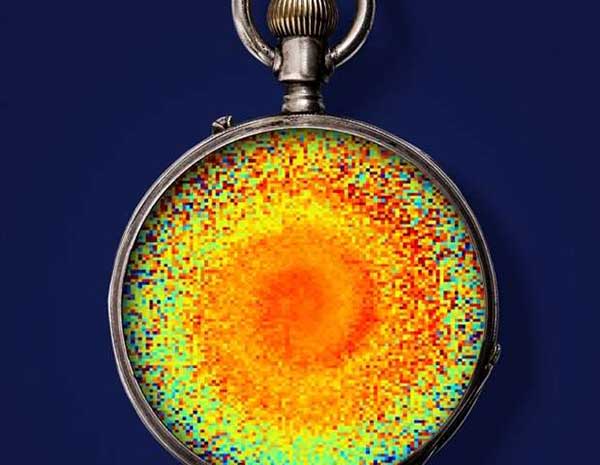
A team led by researchers has found, through the analysis of Gaia data, substructures in the Milky Way that were previously unknown. The findings, which appeared when combining positions and speed of 6 million stars from the galactic disk.
Idaho spot that is the one of the best places in the world to see the Milky Way named America's first 'International Dark Sky Reserve' Daily Mail - December 20, 2017
A giant chunk of central Idaho with a dazzling night sky has become the nation's first International Dark Sky Reserve. The International Dark-Sky Association late Monday designated the 1,400-square-mile Central Idaho Dark Sky Reserve. The sparsely populated area's night skies are so pristine that interstellar dust clouds are visible in the Milky Way.
Extremely massive exoplanet discovered in the Milky Way's bulge PhysOrg - November 6, 2017
As a result of NASA's Spitzer Space Telescope observations of a microlensing event, astronomers have found an extremely massive alien world circling a star located in the Milky Way's bulge. The newly discovered planet, designated OGLE-2016-BLG-1190Lb, is the first Spitzer microlensing exoworld residing in the galactic bulge.
Complex gas motion in the center of the Milky Way PhysOrg - July 14, 2017
How does the gas in the centre of the Milky Way behave? Researchers from Heidelberg University, in collaboration with colleagues from the University of Oxford, recently investigated the motion of gas clouds in a comprehensive computer simulation. The new model finally makes it possible to conclusively explain this complex gas motion.
Origin of Milky Way's hypothetical dark matter signal may not be so dark PhysOrg - May 2, 2017
A mysterious gamma-ray glow at the center of the Milky Way is most likely caused by pulsars - the incredibly dense, rapidly spinning cores of collapsed ancient stars that were up to 30 times more massive than the sun. That's the conclusion of a new analysis by an international team of astrophysicists, including researchers from the Department of Energy's SLAC National Accelerator Laboratory. The findings cast doubt on previous interpretations of the signal as a potential sign of dark matter - a form of matter that accounts for 85 percent of all matter in the universe but that so far has evaded detection.
X marks the spot at the center of the Milky Way galaxy Science Daily - July 19, 2016
Two astronomers -- with the help of Twitter -- have uncovered the strongest evidence yet that an enormous X-shaped structure made of stars lies within the central bulge of the Milky Way Galaxy. Previous computer models, observations of other galaxies, and observations of our own galaxy have suggested that the X-shaped structure existed. But no one had observed it directly; and some astronomers argued that previous research that pointed indirectly to the existence of the X could be explained in other ways.
A source accelerating Galactic cosmic rays to unprecedented energy discovered at the center of the Milky Way Science Daily - March 18, 2016
For more than ten years the H.E.S.S. observatory in Namibia, run by an international collaboration of 42 institutions in 12 countries, has been mapping the center of our galaxy in very-high-energy gamma rays. These gamma rays are produced by cosmic rays from the innermost region of the Galaxy. A detailed analysis of the latest H.E.S.S. data reveals for the first time a source of this cosmic radiation at energies never observed before in the Milky Way: the supermassive black hole at the center of the Galaxy, likely to accelerate cosmic rays to energies 100 times larger than those achieved at the largest terrestrial particle accelerator.
Event Horizon Telescope reveals magnetic fields at Milky Way's central black hole PhysOrg - December 3, 2015
Most people think of black holes as giant vacuum cleaners sucking in everything that gets too close. But the supermassive black holes at the centers of galaxies are more like cosmic engines, converting energy from infalling matter into intense radiation that can outshine the combined light from all surrounding stars. If the black hole is spinning, it can generate strong jets that blast across thousands of light-years and shape entire galaxies. These black hole engines are thought to be powered by magnetic fields. For the first time, astronomers have detected magnetic fields just outside the event horizon of the black hole at the center of our Milky Way galaxy.
Bubbles from the Galactic Center: A key to understanding dark matter and our galaxy's past PhysOrg - January 27, 2015
Compared to other galaxies, the Milky Way is a peaceful place. But it hasn't always been so sleepy. In 2010, a team of scientists working at the Harvard-Smithsonian Center for Astrophysics discovered a pair of "Fermi bubbles" extending tens of thousands of light-years above and below the Milky Way's disk. These structures are enormous balloons of radiation emanating from the center of our galaxy. They hint at a powerful event that took place millions of years ago, likely when the black hole at the center of our galaxy feasted on an enormous amount of gas and dust - perhaps several hundreds or even thousands of times the mass of the sun.
Hidden galactic nuclei PhysOrg - August 10, 2012
At the core of most galaxies including our own Milky Way is a massive black hole. Material falling into the environment of the black hole heats up, and can radiate dramatically, sometimes also powering the ejection of bipolar jets of rapidly moving charged particles. These so-called active galactic nuclei (AGN) are observed to have roughly two types of characteristics: bright, rapidly moving hot gas with dust emission features, or dust absorption with modest (or no) fast gas
Milky Way may have formed 'inside-out': Gaia provides new insight into Galactic evolution PhysOrg - January 20, 2014
A breakthrough using data from the Gaia-ESO project has provided evidence backing up theoretically predicted divisions in the chemical composition of the stars that make up the Milky Way's disc – the vast collection of giant gas clouds and billions of stars that give our Galaxy its 'flying saucer' shape.
Milky Way shaken... and stirred PhysOrg - January 20, 2014
team of scientists headed by Ivan Minchev from the Leibniz Institute for Astrophysics Potsdam (AIP), has found a way to reconstruct the evolutionary history of our galaxy, the Milky Way, to a new level of detail. The investigation of a data set of stars near the Sun was decisive for the now published results. The astronomers studied how the vertical motions of stars - in the direction perpendicular to the galactic disc - depend on their ages. Because a direct determination of the age of stars is difficult, the astronomers instead analyzed the chemical composition of stars: an increase in the ratio of magnesium to iron ([Mg/Fe]) points to a greater age.
The peanut at the heart of our galaxy PhysOrg - September 12, 2013
This artist's impression shows how the Milky Way galaxy would look seen from almost edge on and from a very different perspective than we get from the Earth. The central bulge shows up as a peanut shaped glowing ball of stars and the spiral arms and their associated dust clouds form a narrow band. Two groups of astronomers have used data from ESO telescopes to make the best three-dimensional map yet of the central parts of the Milky Way. They have found that the inner regions take on a peanut-like, or X-shaped, appearance from some angles. This odd shape was mapped by using public data from ESO's VISTA survey telescope along with measurements of the motions of hundreds of very faint stars in the central bulge.
Astronomers discover star racing around black hole at Milky Way center PhysOrg - October 4, 2012
UCLA astronomers report the discovery of a remarkable star that orbits the enormous black hole at the center of our Milky Way galaxy in a blistering 11-and-a-half years - the shortest known orbit of any star near this black hole.
Astronomers weigh in on Milky Way's true colors BBC - January 12, 2012
Astronomers have determined exactly what color our home galaxy the Milky Way is - and find it is aptly named. They wanted to find out how our galaxy looked from the outside - a difficult task given the Earth is inside it. A comparison of star types in other galaxies gives perhaps an unsurprising result: white. But not just any white: specifically, like spring snow at an hour after sunrise or before sunset.
Astronomers determine color of the Milky Way Galaxy PhysOrg - January 11, 2012
A team of astronomers in Pitt's Kenneth P. Dietrich School of Arts and Sciences announced today the most accurate determination yet of the color of the (aptly named) Milky Way Galaxy: "a very pure white, almost mirroring a fresh spring snowfall."
"Diamond" Planet Found; May Be Stripped Star Live Science - August 25, 2011
The newfound planet orbits the pulsar so closely the entire system would fit inside the sun. An exotic planet as dense as diamond has been found in the Milky Way, and astronomers think the world is a former star that got transformed by its orbital partner. The odd planet was discovered orbiting what's known as a millisecond pulsar - a tiny, fast-spinning corpse of a massive star that died in a supernova. Astronomers estimate that the newfound planet is 34,175 miles (55,000 kilometers) across, or about five times Earth's diameter.
Space telescopes reveal previously unknown brilliant X-ray explosion in our Milky Way galaxy PhysOrg - October 22, 2010
Astronomers in Japan, using an X-ray detector on the International Space Station, and at Penn State University, using NASA's Swift space observatory, are announcing the discovery of an object newly emitting X-rays, which previously had been hidden inside our Milky Way galaxy in the constellation Centaurus.
Scientists get a look at the birth of the Milky Way PhysOrg - June 22, 2010
For the first time, a team of astronomers has succeeded in investigating the earliest phases of the evolutionary history of our home Galaxy, the Milky Way. The scientists, from the Argelander Institute for Astronomy at Bonn University and the Max-Planck Institute for Radioastronomy in Bonn, deduce that the early Galaxy went from smooth to clumpy in just a few hundred million years.
There is a giant black hole at the center of our galaxy, a study has confirmed. BBC - December 10, 2008
There is a giant black hole at the centre of our galaxy, a 16-year study by German astronomers has confirmed.
They tracked the movement of 28 stars circling the centre of the Milky Way, using two telescopes in Chile.
The black hole, said to be 27,000 light years from Earth, is four million times bigger than the Sun, according to the paper in The Astrophysical Journal. Black holes are objects whose gravity is so great that nothing - including light - can escape them. According to Dr Robert Massey, of the Royal Astronomical Society (RAS), the results suggest that galaxies form around giant black holes in the way that a pearl forms around grit.
Milky Way's Giant Black Hole 'Awoke From Slumber' 300 Years Ago Science Daily - April 17, 2008
Using NASA, Japanese, and European X-ray satellites, a team of Japanese astronomers has discovered that our galaxy's central black hole let loose a powerful flare three centuries ago. The finding helps resolve a long-standing mystery: why is the Milky Way’s black hole so quiescent? The black hole, known as Sagittarius A* (pronounced "A-star"), is a certified monster, containing about 4 million times the mass of our Sun. Yet the energy radiated from its surroundings is billions of times weaker than the radiation emitted from central black holes in other galaxies.